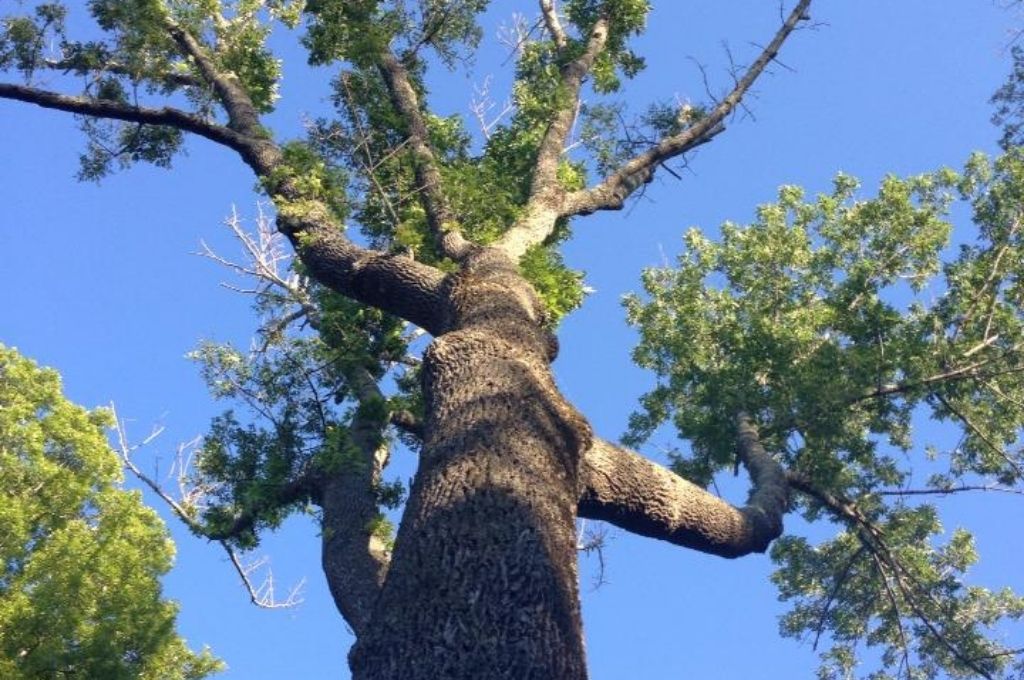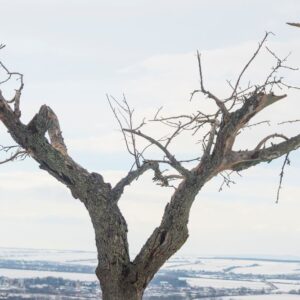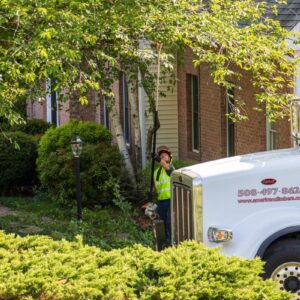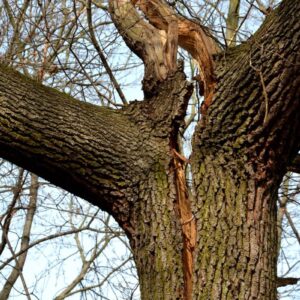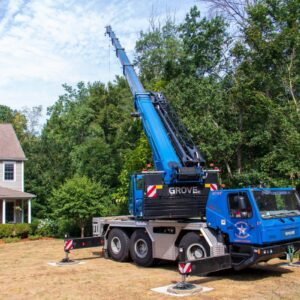With ash trees across Massachusetts dying by the thousands due to infestation with the destructive emerald ash borer (EAB), residents are faced with the question of what to do with their dead ash trees. While you could leave your dead ash tree where it is, we don’t recommend that. Ash trees that have died, especially those killed by EAB, are notoriously brittle, unstable, and prone to unexpected failure (often with no advance warning). The best thing you can do is to cut down and dispose of any dead ash trees. Not only will that make your property safer, but it will also help slow the spread of emerald ash borers.
Here’s what you need to know about dead ash tree removal and disposal options in Massachusetts, including:
- Where EAB is found in Massachusetts
- How the pest damages and kills ash trees
- Prevention and treatment
- Why dead ash trees are a major hazard
- Removing a dead ash tree and why many tree service companies won’t (or shouldn’t!) do it
- How to find a reliable tree company to remove your dead ash trees
- What to do with ash wood after the tree’s cut down
WARNING: Cutting down a dead ash tree is extremely dangerous. Please do NOT attempt to do it yourself!
Do you need to get rid of a dead ash tree? See Tree Removal Preparation.
Emerald Ash Borer in Massachusetts
The destructive EAB arrived in the U.S. in the 1990s and continues to expand its range. EAB is in most parts of Massachusetts and the state is an EAB quarantined zone.
Emerald ash borers are tiny (less than 1” long), bright green insects that lay their eggs in bark crevices. When the larvae hatch, they burrow under bark and begin eating the tree’s outer rings of vascular tissue. This tissue, found just beneath the outer bark, normally sends water and nutrients to branches and leaves. EAB damages this distribution system, and the tree dies from lack of water and nutrients.
There is no way to reverse EAB damage and no cure for infested trees.
Unfortunately, this invasive insect pest is now well-established in Massachusetts. It’s too late to eradicate it so all we can do is try to prevent infestation of valuable ash trees and remove the trees that have been killed.
EAB-Infested Ash Trees Die Quickly
When emerald ash borer populations are high, small trees can die within 1-2 years of infestation. Larger trees may take 3-4 years before dying.
There’s no exact estimate of how long a tree will take to die from EAB. However, we know that If your trees have been attacked by the insect, it’s not a question of if your infected ash tree will die, but how quickly it will happen.
The sad thing is that by the time you notice outward signs of damage, it’s usually too late to save the tree.
Treatments to Prevent EAB Damage
There are some treatments that protect trees from EAB, such as trunk injections and soil injections. However, a homeowner can’t do these treatments themselves. Not only do you need professional equipment, but homeowners also can’t buy the injection solution at retail stores.
The key to these treatments is the right dosage, right application, and the right timing. After a certain point, a systemic treatment won’t save your tree.
If you have a large, valuable, or specimen ash tree that is healthy but at risk for EAB, you might consider having a systemic injection treatment to protect your tree. Be sure to have a certified arborist evaluate your tree first and give you realistic information about treatment outcomes.
Why Dead Ash Trees Are So Dangerous
Ash trees killed by EAB are hazards for several reasons:
- Infested ash trees die quickly, and you can’t always tell how damaged they are from the outside.
- Dead ash wood becomes very brittle, making the tree dangerous to climb and remove.
- Ashwood also cracks and splinters easily, meaning limbs (and a whole tree) can fall with no warning.
As the landowner, it’s your responsibility to remove a dead ash tree before it is deemed a “hazard tree” (some municipalities will even require you to do so). Many insurance companies won’t cover damages caused by a dead ash tree that hasn’t been removed (on the grounds that the homeowner was negligent in not removing it).
These reasons are why we urge homeowners who have ash trees with EAB to remove their trees ASAP. The longer an infected ash tree stays in place, the more difficult it will be to remove, the more expensive the removal will be, and the greater a hazard it becomes.
Many Tree Companies Won’t Remove Dead Ash Trees
Removing dead ash is dangerous work that should always be left to tree care professionals. The tree’s brittle wood can make it too hazardous to climb, and its lack of internal structure makes precise felling cuts unpredictable. If there are utility lines, buildings, or other trees close to the dead ash, removal is even harder.
A reputable tree company that follows safety standards won’t send a climber into a hazardous tree. Instead, they’ll need to use a bucket truck, lift, and/or crane to safely remove the tree in pieces. And not all tree services have that equipment or have the experience to use it safely when dealing with a hazardous tree.
How to Find a Tree Service to Remove a Dead Ash Tree
If you need to remove a dead or dying ash, be sure to hire a company that has the experience, the right equipment, and the safety training for the job. If a company says they can fell or climb the tree, think twice before hiring them.
You’ll want to hire a company that:
- uses trained tree removal specialists,
- is insured and bonded,
- has the equipment and operators needed to safely access the tree, and
- will properly dispose of infected tree waste.
To remove a dangerous dead ash tree that’s unsafe to climb, a company will heed to use a bucket truck, crane, or lift. This specialized equipment and the extra time it takes to safely remove an unstable tree may increase the cost of removing your ash tree. However, leaving a dead ash tree in place will likely have a higher cost in the long term.
What to do With Wood From Your Ash Tree
After you’ve had your ash tree taken down, you’ll have a lot of wood leftover. Most tree service companies will (or can) dispose of the wood for you. However, if you want to use it, ash wood can be safely recycled or reused within your ash quarantine area. Here are a few ideas:
- Grind the wood up into mulch for your garden – EAB will not survive in wood chips 1” or smaller, especially if the wood is composted.
- Chop up the wood for outdoor barbecues and firewood – If you store firewood, be sure to wrap it in tarps so that any EAB in the wood cannot escape from the wrapping.
- Turn it into lumber – If your ash tree is large and you can have it safely removed in large sections, you can mill the wood into planks. Emerald ash borers damage the ring of vascular cells just beneath a tree’s bark but don’t bore into the wood. If you want to mill wood, be sure to tell your tree removal company ahead of time, as salvaging wood requires special removal methods.
If you plan to remove an infected ash tree, please remember:
- do not dump tree waste and
- do not move firewood from your infected tree.
EAB is regularly spread to new areas by these bad practices.
Call Us For Dead Ash Tree Removal
American Climbers specializes in removing large and hazardous trees throughout the Metro West area of Massachusetts. Our skilled crane operators and tree removal crews have years of experience safely dealing with dead ash trees and dangerous trees of all kinds. Many other local tree service companies don’t have the heavy equipment, operators, or experienced crews to remove dead ash trees. If you’re looking for a tree company to take down your ash tree, give us a call at 508-497-8628 – we’re here to help!
Blog Topics
Recent Posts
What's Happening? Stay Informed!
Stay on top of local events, pest and disease updates, tree and landscape tips, and more. Delivered straight to your inbox each month.

